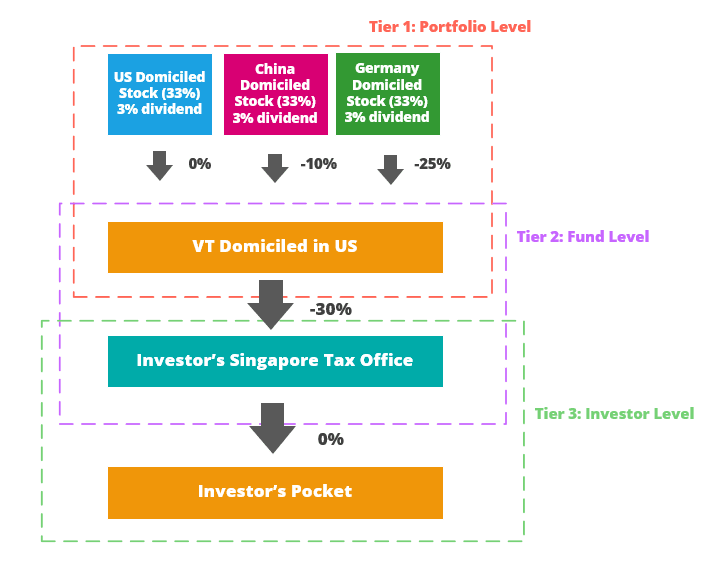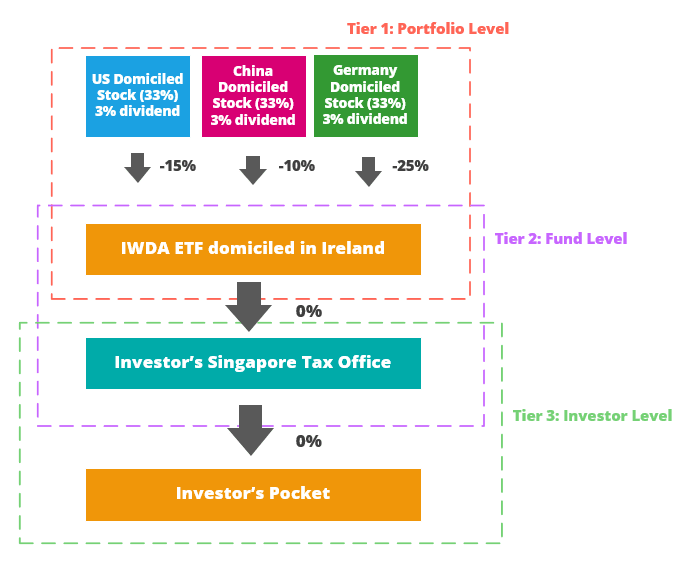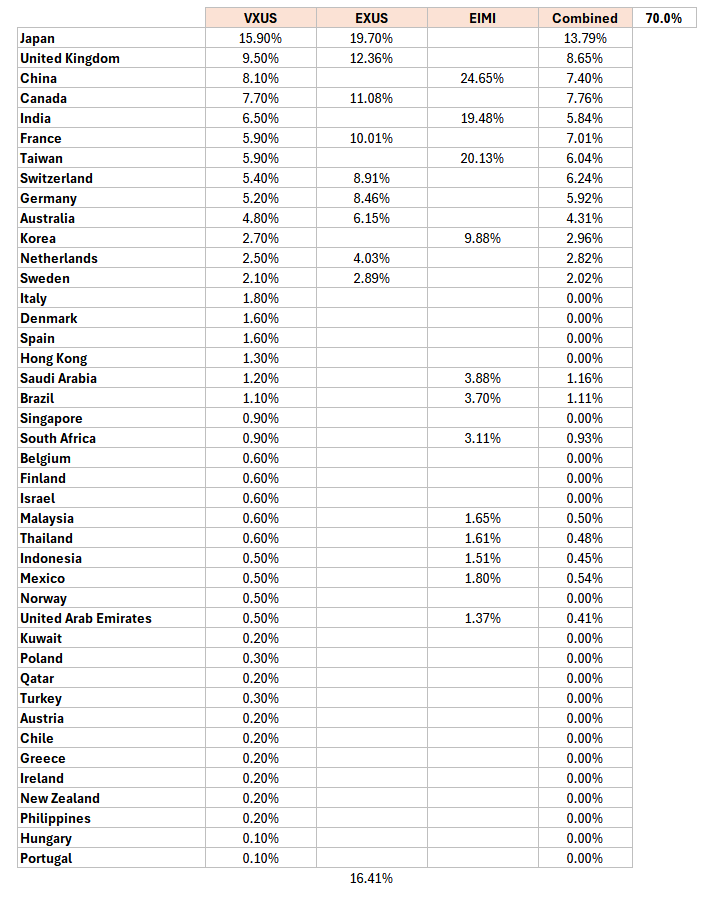I have a dear reader that have something on her mind.
Currently, she express her portfolio with two ETFs:
- Vanguard Total Stock Market Index Fund ETF (Ticker: VTI)
- Vanguard Total International Stock ETF (Ticker: VXUS)
Think she read that dividends that goes out of the US attract 30% withholding taxes for Singapore citizens.
This generated some questions that might affect how she thinks about her portfolio:
- If the dividends of the index funds were reinvested instead, is the 30% withholding tax still applicable?
- What is the impact of the withholding tax on return?
- What would be the the equivalent to replicate VTI and VXUS on the London Stock Exchange?
I will try my best to answer these questions.
If a fund reinvest the dividends, a Singaporean will still be impacted by the withholding tax.
VTI and VXUS are ETFs incorporated in the United States.
Most companies have a withholding tax, which is a tax on money flowing out of the country. This will also depend on what is the nature of the flow. In some countries, money from dividends, interest or royalties are treated differently.
For US it is 30%, Australia it is 30%, Portugal is 25%. Singapore has 0% withholding tax just like UK but REITs in the UK has 10% withholding tax. If you Google a country and “withholding tax”, you should find either PWC or Ernst and Young PDF that will tell you.
Now taxes are withheld when the dividends leave the country.
If your ETF is incorporated in the United States, the dividend from the underlying securities doesn’t leave the country. But the dividend from the ETF leaves the country and therefore still attract the 30% withholding tax.
You can refer to my comprehensive article on Withholding Tax for Singaporean Investors.
I have this example in my article that best illustrates this:

In this example, I show the degree of withholding tax for VT which is a US incorporated ETF. The way to see this is that there might be layers of withholding tax. The underlying stocks such as Apple, China Mobile and SAP would each pay dividend to VT. Apple won’t have withholding tax since it is US to US, but there would be some for China Mobile and SAP.
At the fund level, which is at VT, there is a withholding tax for the dividends from VT to the Singapore investor. If we are strict about it, the dividends will be:
- US dividend: 3% x (1- 0.0) x (1-0.30) x (1 – 0.0) = 2.1%
- China dividend: 3% x (1- 0.10) x (1-0.30) x (1 – 0.0) = 1.89%
- Germany dividend: 3% x (1- 0.25) x (1-0.30) x (1 – 0.0) = 1.575%
- Overall dividend: 1.836%
- Dividend withholding tax cost: 3%-1.836% = 1.163%
Now if you own a UCITS ETF that is domiciled in Ireland instead:


IWDA is domiciled in Ireland, when the dividends from the US stock is paid to the fund, there is 15% withholding tax. Withholding tax on dividends in China is 10% and withholding tax on dividends in Germany is 25%.
ypical dividend withholding tax for United States domiciled companies is 30%, so why is the withholding tax only 15%?
This is because there is a dual taxation treaty between United States and Ireland.
Thus on US, they only withheld 15% of the dividends for taxes.
So this works out to:
- US dividend: 3% x (1- 0.15) x (1-0.0) x (1 – 0.0) = 2.55%
- China dividend: 3% x (1- 0.10) x (1-0.0) x (1 – 0.0) = 2.7%
- Germany dividend: 3% x (1- 0.25) x (1-0.0) x (1 – 0.0) = 2.25%
- Overall dividend: 2.475%
- Dividend withholding tax cost: 3%-2.475% = 0.525%
I hope this example give you a better view of the withholding tax situation.
- There will usually be some sort of withholding tax on the underlying level.
- You might be able to safe on withholding tax on the fund level.
What if the fund is an accumulating fund, which is popular in the UCITS structure where they reinvest the dividends?
The investments in Apple, China Mobile and SAP will be subjected to withholding taxes still (the Tier 1 in those diagrams), but you save on the taxes on Tier 2 because they don’t payout dividends.
Long story short, you still pay some sort of dividend withholding tax, but lesser with Irish domiciled funds.
The Impact of the Withholding Taxes
The numbers presented in the previous section is neutral but we won’t know the impact of the withholding taxes until you calculate them.
I tabulated the historical dividend yield for 2024 for the two funds:
- VXUS: 3.3%
- VTI: 1.2%
I suspect you will be losing like 0.70% based on this.
Is that significant?
If you are trading this, and not in a very fast scraping way, this is probably not that big of an issue. But compounded longer then difference could be bigger.
If you use UCITS ETFs and since Ireland have a dual taxation treaty with the US, you will lose 0.09% roughly (assuming 50% in VTI) from the VTI position but I cannot say how much you would lose from that 3.3% VXUS replacement.
I think the savings here is significant enough.
The More Significant Impact is the Estate Taxes
The savings from the withholding tax pales to the potential magnitude of the estate taxes.
Estate taxes are the taxes incurred on the assets, charged by the country where the assets are when a person passes away. The estate tax in Singapore is 0% but in the US, it ranges from 18-40% for non-resident alien.
Since VTI and VXUS are incorporated in the US, this estate tax is the big potential.
You can read more about estate taxes here: Guide to Estate Taxes for Singaporean Investors with Overseas Investment.
The estate tax for assets domiciled in Ireland for non-residents is 0% and so the LSE alternatives incorporated in Ireland would avoid the problem here.
Equivalent Alternatives to VTI and VXUS
I took a look at the allocation and basically it is:
- VTI: 100% US covering Large, Mid and Small Caps
- VXUS: International stocks Ex US, including Emerging Markets
With two funds you can cover so much is great.
So what are the alternatives?
If you want one fund to cover all, I think IMID is pretty good.
The SPDR MSCI ACWI IMI UCITS ETF tracks the MSCI All Country World IMI Index. The index tracks 8,000 stocks in large, mid and small cap across 23 developed markets and 24 emerging markets.


If you want more finer control then its a bit challenging.
Since the US VTI is large, mid and small cap, you might need to replicate them with:
- CSPX: iShares Core S&P 500 UCITS ETF Acc – US Large Cap
- SPY4: SPDR S&P 400 UCITS ETF Acc – US Mid Cap
- IDP6: iShares S&P 600 UCITS ETF Distributing – US Small Cap
For VXUS, it has a weird mix currently I think the alternative is a combination of:
- EXUS: Xtrackers MSCI World ex USA UCITS ETF 1C – MSCI World ex USA
- EIMI: iShares Core MSCI EM IMI UCITS ETF – Emerging Markets IMI
I compared the current allocation of VXUS and play around with EXUS and EIMI to get the closest mix:


I think a closer allocation is like 70% EXUS and 30% EIMI to replicate VXUS.
So how would the whole thing add up?
My reader will have to play around.
In all honesty, if she wishes to keep it simple, something like IMID will be enough. However, if her investment philosophy is more complicated such that she needs a different percentage of allocation, then having a few UCITS funds might be better.
Hope this is useful for her.
If you have some questions like her, do let me know and I might be able to answer if it is not too complicated.
If you want to trade these stocks I mentioned, you can open an account with Interactive Brokers. Interactive Brokers is the leading low-cost and efficient broker I use and trust to invest & trade my holdings in Singapore, the United States, London Stock Exchange and Hong Kong Stock Exchange. They allow you to trade stocks, ETFs, options, futures, forex, bonds and funds worldwide from a single integrated account.
You can read more about my thoughts about Interactive Brokers in this Interactive Brokers Deep Dive Series, starting with how to create & fund your Interactive Brokers account easily.


